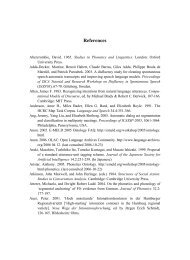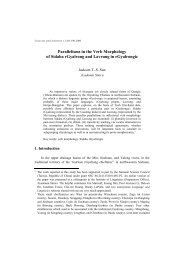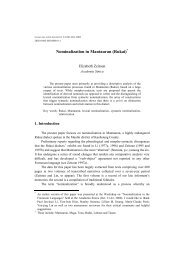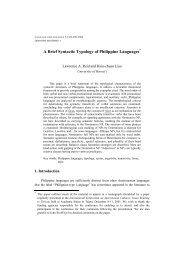Loanwords from English to Malay in the Field of Mathematics*
Loanwords from English to Malay in the Field of Mathematics*
Loanwords from English to Malay in the Field of Mathematics*
You also want an ePaper? Increase the reach of your titles
YUMPU automatically turns print PDFs into web optimized ePapers that Google loves.
<strong>Loanwords</strong> <strong>from</strong> <strong>English</strong> <strong>to</strong> <strong>Malay</strong> <strong>in</strong> <strong>the</strong> <strong>Field</strong> <strong>of</strong> Ma<strong>the</strong>matics<br />
Table 7: Compound loanword percentages for ma<strong>the</strong>matical terms and for<br />
general language<br />
4. Conclusion<br />
General Ma<strong>the</strong>matical<br />
Terms Terms<br />
Analysed Compounds 10% 24%<br />
Nuclear/Marg<strong>in</strong>al Compound<br />
Loanblends<br />
30% 29%<br />
Literal Translations 47% 39%<br />
Syntactic Substitutions 12% 8%<br />
In this study, we have exam<strong>in</strong>ed <strong>the</strong> tendencies <strong>of</strong> ma<strong>the</strong>matical loanwords <strong>from</strong><br />
<strong>English</strong> <strong>in</strong> <strong>Malay</strong>. The aim was <strong>to</strong> determ<strong>in</strong>e if different branches <strong>of</strong> ma<strong>the</strong>matics have<br />
different tendencies <strong>to</strong>wards various loanword types, and if <strong>the</strong> tendencies for<br />
ma<strong>the</strong>matical terms are different <strong>from</strong> those <strong>of</strong> <strong>the</strong> language overall. The clearest<br />
pattern discovered was that ma<strong>the</strong>matical terms <strong>in</strong> <strong>Malay</strong> tend <strong>to</strong> be more similar <strong>to</strong><br />
<strong>the</strong>ir <strong>English</strong> counterparts than do general terms. This is seen most explicitly amongst<br />
<strong>the</strong> s<strong>in</strong>gle-loanword percentages (Table 6), and confirmed amongst <strong>the</strong> compound<br />
loanword percentages (Table 7) -- our sample <strong>of</strong> ma<strong>the</strong>matical terms conta<strong>in</strong>ed 8%<br />
fewer literal loan translations than <strong>the</strong> language at large, and 14% more analysed<br />
compounds.<br />
This may imply that ma<strong>the</strong>matical terms <strong>in</strong> <strong>English</strong> tend <strong>to</strong> be terms <strong>in</strong> <strong>the</strong>ir own<br />
right, ra<strong>the</strong>r than be<strong>in</strong>g semantic extensions <strong>of</strong> o<strong>the</strong>r <strong>English</strong> terms. If this idea is<br />
correct, it would expla<strong>in</strong> our data for compound loanwords -- for transla<strong>to</strong>rs faced with<br />
no natural <strong>Malay</strong> equivalent <strong>to</strong> a term can reasonably be expected <strong>to</strong> form a new <strong>Malay</strong><br />
word based on <strong>the</strong> <strong>English</strong> one. On <strong>the</strong> o<strong>the</strong>r hand, our data may reflect a desire on <strong>the</strong><br />
part <strong>of</strong> a transla<strong>to</strong>r <strong>to</strong> make <strong>Malay</strong> language technical terms similar <strong>to</strong> <strong>the</strong>ir <strong>English</strong><br />
equivalents. In this case, a transla<strong>to</strong>r who could choose an exist<strong>in</strong>g <strong>Malay</strong> term <strong>to</strong> cover<br />
<strong>the</strong> new concept might choose <strong>in</strong>stead <strong>to</strong> form a new <strong>Malay</strong> term, as close <strong>to</strong> <strong>the</strong> source<br />
language as possible.<br />
There are <strong>in</strong>deed two current schools <strong>of</strong> thought regard<strong>in</strong>g this k<strong>in</strong>d <strong>of</strong> choice<br />
(Zubaidi 1992). Some see borrow<strong>in</strong>g as a bad th<strong>in</strong>g, an unavoidable corruption <strong>of</strong> <strong>the</strong><br />
language. O<strong>the</strong>rs see it as a good th<strong>in</strong>g, a way <strong>the</strong> language can be enriched. Sharir<br />
po<strong>in</strong>ts out, <strong>in</strong> (Sharir 1992), that <strong>the</strong> latter school <strong>of</strong> thought appears <strong>to</strong> predom<strong>in</strong>ate<br />
amongst transla<strong>to</strong>rs <strong>of</strong> ma<strong>the</strong>matical works <strong>in</strong><strong>to</strong> <strong>Malay</strong>. He also gives some <strong>in</strong>dications<br />
69










